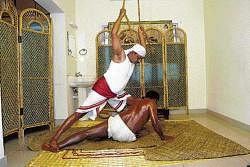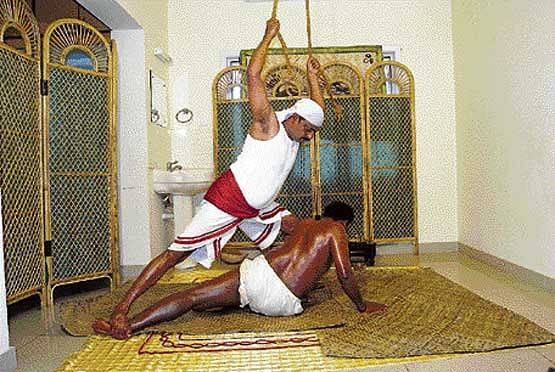

This Indian martial art from Kerala, perhaps one of the oldest combat forms in existence, also covers certain distinctive healing methods under the term ‘kalarichikitsa’. ‘Kalaripayattu’ as well as the ancient medical texts share the concept of ‘vital spots’ in the human body, which is made up of the ‘Pancha Bhootas’ (five basic elements) — air, water, earth, fire and ether.
‘Prana’ (life energy) flows through the body channelled through these vital spots, also known as ‘marmas’. Attacking the vital spots causes the opponent to be stunned, disarmed or even killed, and is essential to the highest stage of training given to most accomplished students in ‘kalari’. In fact, it’s “magic” to those who watch a weak-looking combatant knock down a well-built, muscular man using ‘kalari’ techniques. Just as ‘kalari’ is used for self-defence, it is also used to treat diseases, especially neuro-muscular and orthopedic complaints like low back pain, injury or even fractures.
Like Ayurveda, ‘kalarichikitsa’ too makes use of medicinal oils and herbal preparations to treat a wide range of diseases through manipulation and massage techniques.
Dr Srilatha Shetty, chief of Vishwa Vaidya Ayurvedashram in Vamanjoor near Mangalore, which offers ‘kalarichikitsa’, describes ‘kalarichikitsa’ as a system which activates the vital spots (‘marma’s) of the human body. “For example, whenever there is pain or injury, the usual practice is to treat the injured spot. But in ‘kalarichikitsa’, the ‘marma’ (the junction where joints, nerves and muscles meet) is treated,” she said.
An interesting aspect is that ‘kalarichikitsa’ is administered only at particular time. “The efficacy of the medicine increases say, for example, between 4.30 am and 11 am,” Dr Shetty said.
Murari Gurukal (48), who has been practising ‘kalarichikitsa’ for the last 35 years and lives in Payyanur in Kerala, said that he uses only ‘kashaya’ (decoction), ‘choorna’ (powder), ‘lepa’ (ointment), ‘swarasa’ (juice of fresh leaves) and ‘kalka’ (paste) for those who seek treatment. On the other hand, Dr Venugopalan, Assistant Professor at the Anatomy Department of Periyar Medical College, who has been practising ‘kalarichikitsa’ for the last 30 years, says ‘kalarichikitsa’ is very effective in treating chronic back pain, knee pain, joint pain and arthritis. “However, it depends on who treats the patient,” he asserts.
According to Dr Shyamala of Kasargod, 50 per cent of persons who seek ‘kalarichikitsa’ are healthy people seeking rejuvenation. “A number of people sign up for ‘kalari’ treatment in ‘Karkata masa’ (September) as it is believed that it is more effective during that period when a special variety of rice is used for massage,” she said.